Comet ISON:
First Spectra Images
October 12, 2013
Uploaded
10/12/13

| The
comet has been VERY faint this month as it passes the planet
Mars and moves inward to a sun ward plunge next month. Currently
around 12th magnitude, the activity of the coma is starting to
generate some gas, which was faintly recorded in our spectra
as two broad emissions of C2. Because this comet was so terribly
faint, we installed the Star Analyzer grating in the filter wheel
of the ST10CCD, which made the spectrum short, low resolution
but bright enough to see some details. As the comet brightens,
we can increase our dispersion to show finer details in the month
to come. Here is the process I performed this morning to capture
ISONs spectrum. | 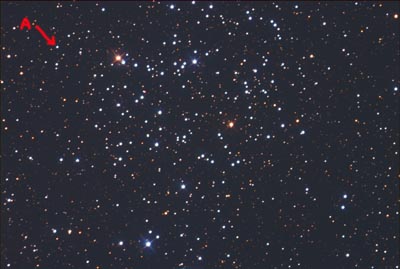 |
First, I shot M35 in Gemini with the CCD.
this is a color shot, 15 minutes RGB. Arrowed
is a A type star used for calibration, since I
had never done this before with this setup.
Normal stars were totally blasted with the
shortest 100mS exposure the CCD would do.
Select an image size for a larger view:
1290 x 960
|
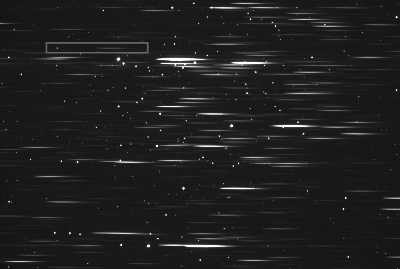 |
Next, I set the filter wheel to rotate in the
SA100 grating. Here is a 10 minute
exposure on the same field as above. The
A type star is boxed here.
Select an image size for a larger view:
1290 x 960
|
 |
Cropping the A star and importing this image
into RSpec allowed a precise calibration of
the wavelengths because I can see the hydrogen
balmer lines here. I ended up with 18.9 Angstroms
per pixel...
Select an image size for a larger view:
1290 x 960
|
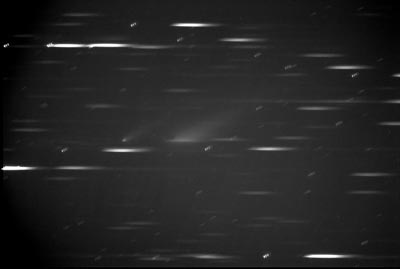 |
Now this is 20 minutes on the comet,
stacked to align the moving comets head
You can see the faint image of the comet
on the left of center, and its spectrum
to its right. Note: stars appear as tripple
streaks because the comet moved during the
20 minutes.
Select an image size for a larger view:
1290 x 960
|
 |
Cropped portion of the image to import
into Rspec...
Select an image size for a larger view:
1290 x 960
|
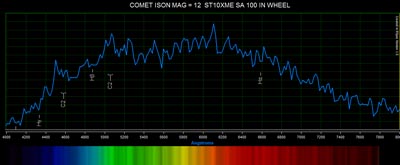 |
Calibrated for wavelength spectra
of ISON. You can see Ive labeled the
C2 emissions, and Balmer lines from
the reflected solar spectrum from the dust
Select an image size for a larger view:
1290 x 960
|
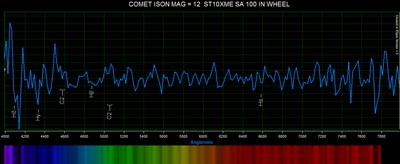 |
Normalized view with labels
Select an image size for a larger view:
1290 x 960
|
 Lens: 12.5" f/5 Home bult Newtonian
Platform: Astrophysics AP1200
Exposure: 5m x 4
Location: Payson, Arizona
Elevation: 5150 ft.
Sky: Seeing 6/10, Transparency 8/10
Outside Temperature: 35F
Processing Tools: Maxim DL, Photoshop CS2
HOME GALAXIES EMISSION NEBS REFLECTION NEBS COMETS
GLOBULARS OPEN CLUST PLANETARIES LINKS
Lens: 12.5" f/5 Home bult Newtonian
Platform: Astrophysics AP1200
Exposure: 5m x 4
Location: Payson, Arizona
Elevation: 5150 ft.
Sky: Seeing 6/10, Transparency 8/10
Outside Temperature: 35F
Processing Tools: Maxim DL, Photoshop CS2
HOME GALAXIES EMISSION NEBS REFLECTION NEBS COMETS
GLOBULARS OPEN CLUST PLANETARIES LINKS

|